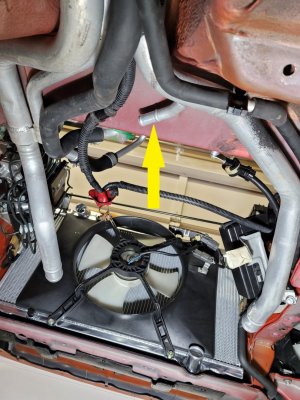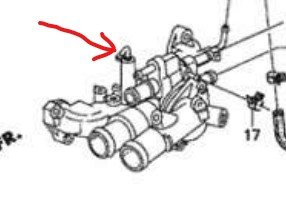I am in the midst of my coolant and coolant hose replacement project. I have opened all the drains except for the engine block drains and have started removing hoses. I have had no trouble finding the engine block drains. Because of all the stuff in the way, as far as I can figure out, the only way to open the drains is going to be using a deep socket on a long extension. I don't think there is any way that I can get a box or open end wrench along with my hand up there to access the drain. On the front drain I am thinking that even getting a deep socket on a long extension up there is going to be a challenge. The interesting part is that the service manual says to attach a hose to the drain to facilitate collection. That is not possible when using a deep socket unless I do the initial release with the deep socket, lightly close the valve and attach the hose and then open the drain. Attaching the hose and then opening the valve with the hose attached is going to be interesting.
Do I have some kind of mental block and I am missing something obvious about how to do this or do most people just skip the hoses, open the drains and let 'er go? Is there some other tool than a deep socket on an extension that is the ideal tool for opening the drains? I am doing this with the car up on jack stands so there is not a huge amount of room to allow quick movement out of the way if the coolant comes out in a rush. I anticipate getting wet. The hoses would have been a nice touch if I could actually get them on the drains and open the drains with them attached. When I look at the drains they look factory new, not a nick or scratch which makes me think that on my previous coolant changes the dealership mechanics might have figured 'not happening' and just used the bottom hose drains and the rad drain to get 'most of the coolant out'.
While on the coolant system topic, how have owners replaced their thermostats? On my 2000 I can see the big hose that goes to the thermostat housing and its attachment point; but, I can only spot the edge of something that might be the bleed valve. I can barely see the actual thermostat housing. The service manual does not indicate that anything has to be removed to do a replacement of the thermostat; but, right now I am thinking something has to move because I can barely see the housing. Some of the stuff will get cleared away as I remove some of the little coolant hoses; but, right now the thermostat housing is looking like an impossible to see and access item. Removing the throttle body - filter box hose may help. Does the throttle body have to come off? Some wisdom / prior experience would be appreciated!
Do I have some kind of mental block and I am missing something obvious about how to do this or do most people just skip the hoses, open the drains and let 'er go? Is there some other tool than a deep socket on an extension that is the ideal tool for opening the drains? I am doing this with the car up on jack stands so there is not a huge amount of room to allow quick movement out of the way if the coolant comes out in a rush. I anticipate getting wet. The hoses would have been a nice touch if I could actually get them on the drains and open the drains with them attached. When I look at the drains they look factory new, not a nick or scratch which makes me think that on my previous coolant changes the dealership mechanics might have figured 'not happening' and just used the bottom hose drains and the rad drain to get 'most of the coolant out'.
While on the coolant system topic, how have owners replaced their thermostats? On my 2000 I can see the big hose that goes to the thermostat housing and its attachment point; but, I can only spot the edge of something that might be the bleed valve. I can barely see the actual thermostat housing. The service manual does not indicate that anything has to be removed to do a replacement of the thermostat; but, right now I am thinking something has to move because I can barely see the housing. Some of the stuff will get cleared away as I remove some of the little coolant hoses; but, right now the thermostat housing is looking like an impossible to see and access item. Removing the throttle body - filter box hose may help. Does the throttle body have to come off? Some wisdom / prior experience would be appreciated!








